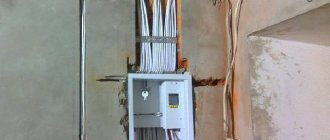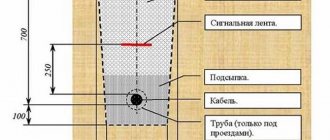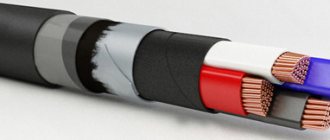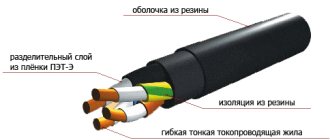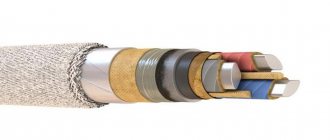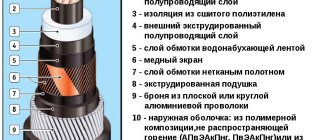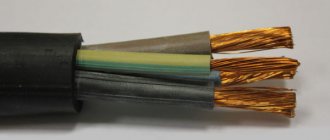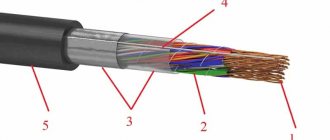KGN power cable is a highly specialized cable product. As the specification states, it is intended for connecting mobile electrical installations to industrial electrical networks - for example, mounted on certain self-propelled mechanisms. Actually, this is a specific variation of the standard CG - a flexible cable with copper conductors, but with its own scope of application.
The KGN wire was originally intended (and is still actively used) for use on river and sea vessels and warships. It uses rubber insulation rather than polyvinyl chloride, which increases the resistance of the wire to waterlogged air, salt water, various oils, disinfectant chemicals and other types of aggressive environments. At the same time, the disadvantage of this wire is its vulnerability to sunlight - under their influence, the rubber coating quickly loses flexibility and begins to decompose.
KGN cable: description and characteristics
Home » Electrical wiring » Wires and cables » KGN cable: description and characteristics
The KGN power cable is a modification of the popular KG cable, which we have already talked about. If we talk about the differences between these products, then it is worth highlighting their resistance to combustion and moisture. Such features of the conductor made it popular, so we decided to tell in more detail the technical characteristics, description, decoding and talk about the scope of application.
Cable KGN decoding
Initially, it’s worth talking about the abbreviation; it looks like this:
- K is a cable.
- G – he is flexible.
- N – there is an insulating layer of sodium rubber, it does not burn.
There are several types of cable - this is KG-HL, which is intended for cold climates and KG-T, which is tropical.
Conductor design
- The cable is copper. The structure is multi-wire, round in shape.
- The flexibility of the cable is 5, all this is confirmed by GOST 22483.
- The insulation is rubber, it corresponds to the markings of cables and wires.
- A special layer is applied over the core; it prevents the insulation from sticking.
- The shell is made of rubber, which does not burn and is not afraid of moisture, which adds increased performance.
- The KGN cable is multi-core, so all the wires are twisted. The twisting pitch cannot exceed 16 diameters.
You can see the design in more detail in this photo:
Technical characteristics of the KGN cable
Now we move on to the most important thing - the technical characteristics of the cable, they look like this:
- Frequency 400 Hz.
- Operating temperature -30+50. If we are talking about the KGN-T cable, then the operating temperature is from -10 to +55 degrees.
- Rated voltage 1 kV – constant and 0.66 kV – alternating.
- The service life is short, only 2.5 years from the date of production.
- The warranty begins from the moment of installation or when six months have passed after its purchase.
- The conductor is manufactured in accordance with TU 16.K73.05-95 standards.
- The minimum temperature for laying is 15 degrees.
- The maximum permissible heating is 75 degrees.
- The bending radius during installation is 8 outer diameters.
If we talk about other technical characteristics, then it is worth highlighting its cross-section, rated voltage and weight, you will find all this in the table:
In the following table you will find the permissible conductor current depending on its cross-section.
Application area
This cable is considered universal, because it has a number of characteristics that other conductors cannot boast of. It can be used:
- In places where there is high humidity. It is also suitable for installation under water, but the integrity of the insulation must be checked before installation.
- The conductor is often used in shipbuilding.
- It has also found application in production. After all, he is not afraid of aggressive substances and is strong. It can be connected to mobile equipment.
- It can also be used for wiring in basements. It is not afraid of moisture and is best suited for such installation.
Note! It is better not to lay such a cable underground, even if there are more efficient conductors, such as VBBShV copper cable. It is also better not to use it in the sun, because the insulation can be deformed due to sunlight
To avoid this, you can apply additional insulation, although this is not entirely logical.
Scope of application
This product is mainly used to provide electricity to mobile consumers (cars and machinery) from DC networks.
The resistance of the insulating sheath to water, lubricants and various aggressive chemicals allows the cable to be used in mines, cellars, enterprises with high humidity, submarines, as well as in agriculture. Cables with a small cross-section can be used to connect household and household appliances.
Such a cable can be used for laying electrical wiring, but it must be remembered that it cannot be bent to sharp corners (the minimum radius must be greater than 8 diameters).
Laying outdoors is allowed, with an operating temperature range from −30°C to +45°C. An additional advantage will be the coloring of the wires. This will help you avoid confusion when connecting.
Wire KGN 5×10
Current questions on the topic
Question No. 1. Why do GKN cables, in addition to power and grounding conductors, contain additional wires of a smaller cross-section?
These wires are used to remotely control equipment or connect additional equipment, such as communications equipment.
Question No. 2. Is it permissible to use a flexible cable in a rubber sheath for underground installation?
Theoretically, this is possible, but only when placed in a plastic or metal pipe and the absence of splices and twists must be checked. Such a gasket should not be designed for many years of use.
Question No. 3. If GKN is allowed to be used in a mine, then perhaps it can also be used in a cellar?
Absolutely right. Neither relative cold, nor condensation, nor the effects of mold are harmful to the cable.
Question No. 4. Does the permissibility of open wiring mean the possibility of outdoor use?
According to temperature indicators, outdoor use is quite acceptable. But it is advisable to avoid exposing the product to prolonged exposure to direct sunlight in the summer. This may cause the rubber casing to dry out and crack.
Rate the quality of the article
Your opinion is important to us:
Explanation and design characteristics
The marking of any cable product is based on the materials of manufacture, conditions of use and technical and operational characteristics. In the case of KGN, when decrypting, we get the following result:
- K – power cable;
- G – flexible;
- N – nairite rubber (external insulation).
Nairite rubber is familiar to many under another name - vulcanized rubber. Vulcanization uses zinc and magnesium oxides, and the main advantage of the product is its high resistance to many reagents, including solvents, petroleum products, acids, vegetable or mineral oils. Additional advantages of nairite rubber are increased strength and resistance to mechanical abrasion. Even when heated to 95 degrees. Celsius outer shell retains its positive qualities and does not support combustion.
When marking a cable, after the KGN there may be a hyphen and a few more letters that indicate the climatic version. The KGN-T wire is successfully used in tropical conditions, since it can cope with the effects of mold fungi. The KGN-HL cable can be used at critically low temperatures. The presence of the ls prefix means low release of harmful toxic substances when heated.
In addition to letter markings, digital markings are used. The first number indicates the number of cores in the cable, the second is separated from the first using the multiplication sign and indicates the cross-section of the individual conductors. For example, if you see the marking KGN-T 2×3, you can decipher it as a flexible power cable with nairite insulation, two cores of 3 sq. mm each, designed for use in the tropics.
Each core in a KGN cable is made from many small wires. Typically, tinned tin or its mixture with lead are used for their manufacture. The tin content in such mixtures should be from 40%. The complex composite design of the KGN involves the use of several components:
- Stranded core with a flexibility class of at least five. In cross-section it has a round cross-section.
- The cores are insulated with nairite or butadiene rubber.
- A layer of polyethylene terephthalate is placed between the tin (copper) and the shell. This is necessary to prevent sticking between these materials.
- The outer shell is made of polychloroprene rubber RSHN-1.
- An additional film of polyethylene terephthalate or talc, which prevents sticking of other rubber compounds (core insulation and outer shell).
All of the listed intermediate layers are a characteristic feature of KGN, which distinguishes it from other types of wires. On the other hand, this leads to an increase in the cost of the cable due to the presence of specific parameters. The KGN can be used in industrial, administrative and residential facilities, provided that the sun's rays do not fall on it. On the other hand, there are no aggressive environments in residential and administrative buildings, so the use of this modification is impractical. Instead of KGN, it is better to take the same KG.
The twisting pitch of the cores in the KGN should not exceed 16 of its own diameters. Often the design includes one or two conductors of reduced cross-section, used as neutral and grounding conductors. In this case, the marking includes additional designations, and the number of reduced cores and their cross-section are indicated through the addition sign. For example, KGN-T 2×3 + 2×1 consists of two cores with a cross-section of 3 square meters. mm and two 1 sq. mm.
The maximum permissible number of cores for KGN is five (regardless of the diameter), the minimum is one. The cross-sectional area of individual conductors ranges from 0.75 to 120 square meters. mm.
Purpose and operating conditions
TPPEP cable
A distinctive feature from other similar products is that KGN has a rubber rather than polyvinyl chloride shell. The rubber shell is resistant to high humidity and aggressive environments: salts, oils, chemicals. KGN was specially designed for use on sea vessels.
Attention! The main disadvantage of the KGN cable is the negative impact of ultraviolet radiation. Prolonged exposure to sunlight hardens polychloroprene rubber and it begins to crack and decompose.
This makes further exploitation dangerous and impossible.
Who can be part of a consolidated group?
The CGN participant must fulfill the following conditions:
- Don't reorganize
- Do not liquidate.
- Not undergo any of the bankruptcy procedures (other than supervision).
- Net assets must not be less than the authorized capital.
In addition, there are restrictions related to the specifics of the activity.
Note!
Companies that are exempt from paying NP or use special regimes cannot be included in the CTG. Participation in two or more group groups at the same time is prohibited.
Financial sector organizations generally cannot be members of the consolidated group of taxpayers. However, banks, insurers, non-state pension funds and brokers can form “special” CGNs, consisting only of financial institutions of the corresponding type.
Choosing a cable for welding
The stability of welding work is influenced not only by the characteristics of the voltage source, but also by the parameters of the network and welding cable. Therefore, the correct selection of length, section and material from which it is made is of great importance. Welding currents in some cases reach 300 A or more, and we will tell you how to choose the right type and material for your job. We will also consider the topic of welding optical fiber cables, the composition of the equipment necessary for this and the sequence of work.
Parameters, types and selection of welding cable
Any welding cable has a certain electrical resistance, which can be calculated using tables, for example, an aluminum conductor has a higher resistance than a copper one. Therefore, a network extension cord will require a larger cross-section and a significant number of kilograms of aluminum wire. Taking this factor into account, the network wires are extended by no more than 40 m and a two- or three-core copper cable with a cross-section of more than 2.5 mm2 is chosen for this. Unlike network wires, welding cables are selected based on the output current and use stranded copper grades with improved insulation and increased flexibility.
The most common cables for welding are marked KG (flexible) or KOG (increased flexibility) and have multi-layer insulation of current-carrying conductors with a rubber outer coating. The wire length is usually 2-3 m because increasing this parameter by 1 m requires an increase in cross-section by 1.5 times the calculated one due to increased resistance and excessive heating. When choosing a product brand, it is necessary to take into account the operating conditions in order to select the type of insulation resistance to mechanical damage and temperature conditions. The conductor is marked depending on operating conditions as follows:
- welding cable type KG T 1X16 means tropical (T) version from -10 to +55 °C, single-core with a core cross-section of 16 mm2;
- product KOG HL 1X50 means cold-resistant (HL) from -60 to +50 °C, with an effective cross-section of 50 mm2;
- if the heat resistance index is not present, then the conductor can withstand from -40 to +50 °C;
Of particular importance is the cross-section of the welding cable, on which the strength of the operating current and the efficiency of the process depend. The choice for this parameter is based on matching the expected current strength and the cross-section of the conductive core according to the following principle:
- current up to 180 A is allowed to work with the KG 1X16 brand;
- at a current of 230 A, KG 1X25 is suitable;
- current 280 A allows work with a core cross-section of 35 mm2;
- 350 A corresponds to type KG 1X50;
- brand KG 1X70 allows a current of 430 A;
Welding of fiber optic lines
Modern technology allows us to avoid signal loss when transmitting over long distances; fiber optics are used for this. The product contains translucent threads with a reflective coating, through which the high-frequency signal passes without attenuation. The optical cable is laid for communication needs for various purposes and is an noise-proof, encrypted transmission link between subscribers. There are multimode and single-mode lines that differ in signal quality and price, but provide ideal isolation between communication nodes.
When installing lines of this kind, it becomes necessary to weld the fiber optic cable, which is a complex engineering task, since the thickness of the central core is 62.3 microns. For this purpose, special welding devices are used, which minimize quality losses and consist of the following components, namely:
- video control unit with monitor;
- heat shrink device with carriage and electric drive;
- guides with optical and mechanical correction systems;
- fiber optic welding module with arc creation unit;
- processor control board with controllers;
- source of supply voltage and welding current.
Units for welding optical waveguides have autonomous, classified software and an interface that allows maintaining high confidentiality of data transmission.
Let's sum it up
We looked at the topic of choosing a welding cable, its varieties and operating conditions
It is very important to make the right decision to avoid extreme equipment operation and accidents. We also touched upon the topic of welding fiber optic lines and equipment for this work.
We will be glad if this information is useful to you.
Sergey Odintsov
electrod.biz
Smoke from fire
A dream in which you saw smoke from a fire indicates your unstable emotional state. You are in a constant state of anxiety, fear and aggression that you cannot control. This condition threatens quarrels and conflicts.
Try to find a way out for negative emotions. Don't be afraid to express your feelings - this will relieve emotional stress.
Characteristics of heat-resistant wire PRKA
Like prks brand products, these wires belong to the category of heat-resistant cable products, but have a number of differences in structure. PRKA is a single-core cable; this characteristic is not even indicated in the marking, since all PRKA contain one core by default. Prx cable, on the contrary, is also available in multi-core versions. These are the options that are most in demand among buyers.
Important! Temperature-resistant products of the PRKA and PRKS brands are produced not according to state standards, but according to technical specifications. For the first of them this is standard 16-505.317-76, for the second - 16 K71-379-2007 or TU16.K138-001-2006
Sections
PRKA type products are available in the following cross-sections: 0.5, 0.75, 1, 1.5 and 2.5 mm2. For all of them, with the exception of the last one, the insulating layer has a thickness of 0.6 mm (for a core cross-section of 2.5 mm2 it is 0.8 mm).
Important! The maximum deviation of the insulation thickness downward will be 10%. For the most part, this parameter is not strictly regulated.
PRKS products, on the contrary, are produced in an assortment of designs with the number of cores from one to five, and each of the core elements includes a plurality of wire pieces. Thus, this wire has a more complex structure. The thinnest core options have a cross-section of 0.75 square millimeters, the thickest - 16. When a three-phase consumer is connected to the electrical network using such a cable, the wire can withstand loads of up to 45 kilowatts.
Since a wide range of possible cross-sections of cores and their number in one cable gives a significant range of design options, different types of RPKS are subject to different design restrictions associated with operation at a certain voltage value:
- For wires designed for operation at a rated voltage of 380 V, the thickness of the insulating layer for conductors with a cross-section of 0.75-1.5 mm2 should be 0.6 mm, for conductor elements with a cross-section of 2.5-6 mm2 - 0.8 mm, for the thickest versions with a cross-section of 10 and 16 mm2, it is equal to one millimeter.
- A voltage of 660 V requires a larger insulation thickness: for thin conductors of 0.75-1.5 mm2 it will be equal to 0.8 mm, for medium ones (2.5-6 mm2) - 1 mm, thick conductors are supposed to have an insulating layer of 1.2 mm.
- The thickness of the shell itself does not depend on the operating voltage and is determined only by the cross-sectional parameter of the core elements. For the thinnest group of cores it is equal to a millimeter, for options of 2.5-6 mm2 - 1.1 m, for cores with a cross section of 10 and 16 mm2 - 1.2 mm.
PRKS section
How to conclude an agreement to create a consolidated group
The agreement on the creation of the CG indicated the following important points:
- item;
- list of parties to the agreement and their contact/registration information;
- company name - OUKG;
- information about the responsibilities of each member of the group and separately OUKG (timing and procedure for execution), as well as information about the responsibility that arises due to failure to fulfill the terms of the contract;
- the validity period of the CG, and, accordingly, the contract;
- the amount of information provided by each member to determine the tax base and pay income tax.
You may find the tax information contained in the article “What is the object of taxation for income tax?” useful.
The agreement on the creation of a corporate group was subject to mandatory registration with the tax authority. In order to register it, the OUKG had to collect a complete package of documents. It included:
- the contract itself (in 2 copies);
- statement of establishment signed by all members of the CG;
- documents confirming the powers of the signatories of the agreement;
- accounting and financial documents confirming that all members of the group have the right to create a group of companies (information requiring confirmation is specified in subparagraphs 2–3, 5 of article 25.2 of the Tax Code of the Russian Federation).
The data that needs to be confirmed is certified by the OUKG. This list includes copies of financial statements, payment slips confirming the payment of taxes and excise taxes.
All these documents had to be submitted by October 30, so that starting next year, group members could work and pay taxes within the CG. After submitting documents to the tax authority, a decision was made within a month to register the agreement or refuse it.
If the Federal Tax Service has discovered correctable violations that can be corrected within the allotted month, the OUKG is notified of this and is obliged to eliminate them in a timely manner.
If all formalities regarding compliance by participants with the requirements of Art. 25.2 of the Tax Code of the Russian Federation, and there is also a full package of documents, the agreement on the creation of the CG is registered. Within 5 days, 1 copy of the agreement is issued with a note about the registration.
Next, the Federal Tax Service that carried out the registration notifies all territorial tax authorities in which the participants of the group are registered about their status. The same notifications are sent to the INFS, where separate divisions of companies that are members of the CG are registered.
If all the described formalities were observed, the CG was recognized as created on January 1 of the year that occurred after the registration of the agreement on the creation of the CG.
Description of technical parameters of the KGN cable
One of the most common power conductors is the KGN cable. It is an improved (oil-resistant and flame-resistant) version of the popular KG conductor. This type of cable is widely popular among electricians because it is suitable for connecting high-power electrical appliances.
The name KGN has a fairly simple and understandable interpretation: K is a cable, G is flexible, and N is a symbol that denotes an insulating layer made of non-flammable oil-resistant rubber. There are several options for this conductor: KG-HL for cold climates and KG-T for the tropics.
Scope of application
The technical parameters of the KGN cable allow it to be used in conditions of high humidity and even under water (in rivers, lakes). This conductor was originally developed for use in the shipbuilding industry. It is widely used in rooms with high air humidity and the presence of moisture condensation on the walls and ceiling. Such premises include basements and rooms on ships.
In addition, the cable can be used in various aggressive environments, for example, in a mine to connect mobile electrical equipment. Resistance to disinfectant solutions and lubricating oils allows it to be used in agriculture. But for underground installation it is recommended to use an armored copper conductor, for example, VBBShV.
KGN can be used in rooms with natural ventilation, provided that the cable is not exposed to precipitation and sunlight. Laying the KGN in open areas is only possible if the conductor is protected from solar exposure. This is due to the fact that its insulation is destroyed under the influence of ultraviolet rays.
Cable design
The cable consists of copper conductors in quantities from 1 to 5. The cross-section of each conductor varies from 1 to 240 mm. The conductor design is as follows:
- A conductor made of copper that conducts current. The core is characterized by a multi-wire structure and a round shape. Flexibility class – 5 (according to GOST 22483).
- A separating layer that prevents insulation from adhering to the surface of the conductor. This layer is a PET-E synthetic film.
- Insulating layer. Each core is covered with insulation made of rubber type RTI-1 based on rubbers. Color marking of insulating coatings of conductors (phase, neutral and grounding) is carried out in accordance with existing standards.
- A separating layer that prevents the inner insulation from sticking to the outer sheath of the cable. Talc or PET-E synthetic film can be used as a separating layer.
- The outer shell is made of oil-resistant rubber that does not propagate combustion. This is RSHN-1 rubber, made on the basis of polychloroprene. This sheath gives the cable increased performance characteristics. The presence of such a sheath is the main difference between the KGN cable and the KG conductor.
If the KGN electric cable is multi-core, then the cores are twisted together in increments that do not exceed 16 diameters along the entire length of the product.
Basic parameters of the conductor
The main question that interests consumers is what are the technical characteristics of the KGN cable? So, this conductor is manufactured in accordance with TU 16.K73.O5-93 and is characterized by the following parameters:
- The AC frequency is 400 Hz.
- The alternating rated voltage is 0.66 kV, and the constant voltage is 1 kV.
- The minimum permissible bending radius when laying the conductor is 8 outer diameters.
- The operating temperature of a standard KGN product varies from -30 to +50 degrees Celsius. The tropical version of the KGN-T design can be operated at temperatures from -10 to +55 degrees.
- The maximum permissible heating of the cable cores during operation is no higher than +75 degrees.
- Cable laying without preheating can be carried out at an ambient temperature of at least -15 degrees.
The construction length of a cable with a cross-section of 35 mm2 is at least 150 m, with a cross-section of 50-120 mm2 - 125 m and more, with a cross-section from 155 mm2 - at least 100 m. The warranty period for the operation of the KGN is 6 months from the date of use of the cable line, but at the same time no more than 1 year from the date of production. The cable service life is 2.5 years from the date of manufacture.
The largest domestic producers of KGN are Kolchuginsky, as well as Rybinskkabel, Kamkabel, Sevkabel. They make the most reliable and high-quality products. The foreign analogue of this conductor is considered to be the NSSHOU brand.
normdom.ru
Manufacturers
Currently, there are many factories producing cable products. To avoid falling for a fake, it is recommended to choose the most proven ones. If a person is at a loss as to which factory to give preference to, you can visit the forum of electricians, who will tell you exactly which companies are more in demand. Below is a list of leaders in the Russian market.
"Electrocable" Kolchuginsky plant
The factory is located in the Vladimir region. It was founded back in 1939. The assortment includes more than 100,000 thousand brand sizes of products. The plant has an impeccable reputation, many good reviews and awards. They produce cables manufactured using the latest technologies. The main advantage will be the latest equipment from Germany and Hungary.
Product manufacturing process
"Kamkabel"
One of the largest factories for the production of cable products in Europe and Russia. The entire range presented is always in stock. They deliver to anywhere in the world, by air, trains and cars. There are more than 55,000 thousand macro sizes available. There is a testing center on the territory of the plant, so all products are of high quality.
"Rybinskkabel"
The company was founded in the 50s of the last century. There are more than 35,000 thousand brand sizes available. The manufacturer has fairly reasonable prices for the products. We have experience in supplies for large nuclear power plants. In 2015, the plant won one of the Russian competitions as the best new product of the year. The factory provides the largest guarantee of all the above-mentioned enterprises. Over the past few years, branches of the plant have appeared in different cities of the country.
GC "Sevkabel"
This is one of the first cable factories in Russia. The plant was founded back in 1879 by a German scientist. The company produces more than 25,000 thousand types of mark sizes. The factory has an impeccable reputation. At the end of 2022, the company plans to complete its modernization and introduce new technologies for the production of cable products.
Various macro sizes
In conclusion, it should be noted that it has many advantages. Therefore, every year it is increasingly used in everyday life. This cable is perfect for connecting mobile electrical machines.
